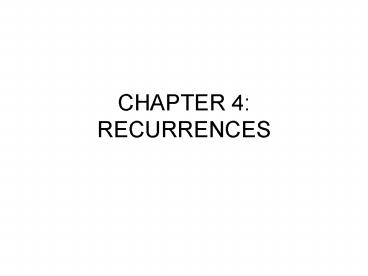CHAPTER 4: RECURRENCES - PowerPoint PPT Presentation
1 / 12
Title:
CHAPTER 4: RECURRENCES
Description:
As noted in Chapter 2, when an algorithm contains a recursive call to itself, ... When you hit such a snag, revising the guess by subtracting a lower-order term ... – PowerPoint PPT presentation
Number of Views:43
Avg rating:3.0/5.0
Title: CHAPTER 4: RECURRENCES
1
CHAPTER 4 RECURRENCES
2
- As noted in Chapter 2, when an algorithm contains
a recursive call to itself, its running time can
often be described by a recurrence. A recurrence
is an equation or inequality that describes a
function in terms of its value on smaller inputs.
- This chapter offers three methods for solving
recurrences--that is, for obtaining asymptotic T
" or "O" bounds on the solution. In the
substitution method, we guess a bound and then
use mathematical induction to prove our guess
correct. The recursion-tree method converts the
recurrence into a tree whose nodes represent the
costs incurred at various levels of the
recursion. The master method provides bounds for
recurrences of the form - T(n) aT(n/b) f(n),
- where a1, b gt 1, and f(n) is a given
function it requires memorization of three
cases, but once you do that, determining
asymptotic bounds for many simple recurrences is
easy.
3
Technicalities
- In practice, we neglect certain technical details
when we state and solve recurrences. For example,
recurrence describing the worst-case running time
of MERGE-SORT is really - we normally state it as
4
4.1 The substitution method
- The substitution method for solving recurrences
entails tow - 1.Guess the form of the solution.
- 2.Use mathematical induction to find the
constants and show that the solution works. - This method can be used to establish either upper
or lower bounds on a recurrence.
5
Making a good guess
- Unfortunately, there is no general way to guess
the correct solutions to recurrences. Guessing a
solution takes experience and, occasionally,
creativity. Fortunately, though, there are some
heuristics that can help you become a good
guesser. You can also use recursion trees to
generate good guesses. - If a recurrence is similar to one you have seen
before, then guessing a similar solution is
reasonable. As an example, consider the recurrence
6
Subtleties
- There are times when you can correctly guess at
an asymptotic bound on the solution of a
recurrence, but somehow the math doesn't seem to
work out in the induction. Usually, the problem
is that the inductive assumption isn't strong
enough to prove the detailed bound. When you hit
such a snag, revising the guess by subtracting a
lower-order term often permits the math to go
through.
7
Avoiding pitfalls
- It is easy to err in the use of asymptotic
notation.
Changing variables
- Sometimes, a little algebraic manipulation can
make an unknown recurrence similar to one you
have seen before.
8
4.2 The recursion-tree method
- In a recursion-tree, each node represents the
cost of a single subproblem somewhere in the set
of recursive function invocation. We sum the
costs within each level of the tree to obtain a
set of per-level costs to determine the total
cost of all levels of the recursion. Recursion
trees are particularly useful when the recurrence
describes the running time of a
divide-and-conquer algorithm.
9
4.3 The master method
- The master method provides a "cookbook" method
for solving recurrences of the form - T(n) aT(n/b)f(n),
- where a1 and b gt 1 are constants and f(n) is an
asymptotically positive function. The master
method requires memorization of three cases, but
then the solution of many recurrences can be
determined quite easily, often without pencil and
paper.
10
The master theorem
- Let a1 and b gt 1 be constants, let f(n) be a
function, and let T(n) be defined on the
nonnegative integers by the recurrence - T(n) aT(n/b) f(n),
- Then T(n) can be bounded asymptotically as
follows. - 1. If f(n) for some
constant egt 0, then T(n) . - 2. If f(n) , then T(n)
. - 3. If f(n) for some
constant egt 0, and if af(n/b)cf(n) for some
constant c lt 1 and all sufficiently large n, then
T(n) T(f(n)).
11
- In each of the three cases, we are comparing the
function f(n) with the function nlogba.
Intuitively, the solution to the recurrence is
determined by the larger of the two functions.
If, as in case 1, the function nlogba is the
larger, then the solution is T(n) O(f(nlogba).
If, as in case 3, the function f(n) is the
larger, then the solution is T(n) OT(f(n)). If,
as in case 2, the two functions are the same
size, we multiply by a logarithmic factor, and
the solution is T(n) T (nlogba lg n) T(f(n)lg
n).
12
Using the master method
- To use the master method, we simply determine
which case (if any) of the master theorem applies
and write down the answer.































